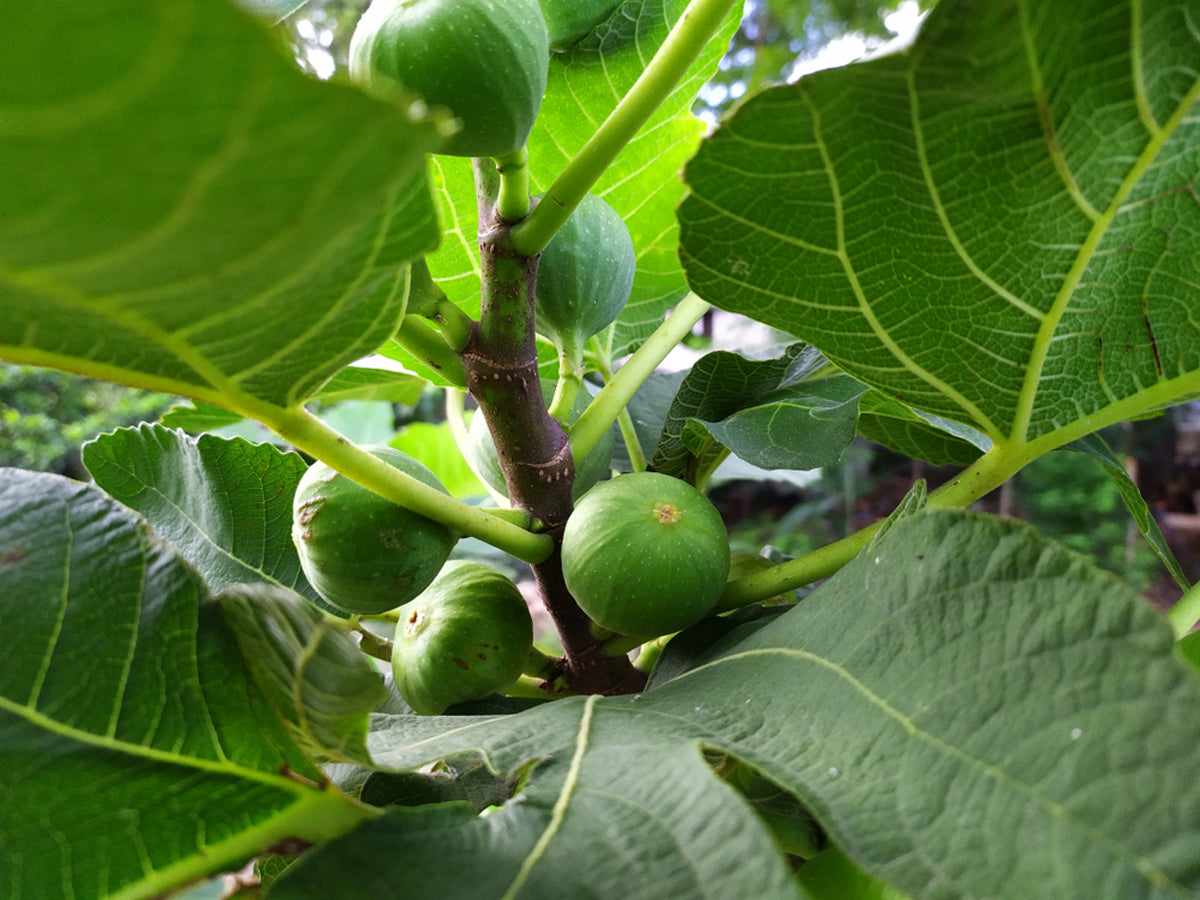How to Grow
How to Grow Anjeer Fig Tree: Benefits, Uses & Care Tips
Have you ever heard of "anjeer," also known as fig in English?
Anjeer is a juicy and sweet fruit that has been enjoyed in both dried and fresh forms for thousands of years.
Growing your own anjeer tree is not only a rewarding experience but also effortless in the right conditions. With proper care, you can have your tree bearing fruit in just a few years. Imagine the satisfaction of biting into a sun-ripened anjeer, freshly picked from your backyard. Additionally, there are many anjeer dry fruit benefits that you can take advantage of.
Start growing your anjeer tree today and experience the joy of growing and harvesting your own fruit. In this blog, we will provide you with all the necessary information about anjeer trees, including how to grow, care for, and use them. Discover the rich history, uses, and numerous health benefits of anjeer, and start enjoying this versatile plant.
Here we will discuss:
- Facts About Anjeer
- Benefits of Growing Anjeer
- How to Grow Anjeer Plant At Home
- How To Take Care of Anjeer Plant
- Uses of Anjeer Plant
Facts about Anjeer
- Cultivated for over 11,400 years, figs were one of the first fruits grown by humans and served as a staple food in ancient civilizations, including Greece, Rome, and Egypt.
- Figs are culturally significant in Judaism and Islam, with the Bible referencing them as a symbol of prosperity, and Islam considering them a blessed fruit often served during Ramadan.
- With a rich cultural history, figs have been associated with Greek mythology's god of agriculture, Demeter, and symbolize abundance in Turkish culture, often gifted to friends and family and used in art and literature for centuries.
- Anjeer has a unique reproductive process known as caprification. This process occurs when a tiny wasp, called the fig wasp, enters the fig through a small opening and pollinates the flower. After mating, the males create a hole in the fig, enabling the females to fly out and find fresh figs.
- People eat anjeer fresh, dried, or in various forms, such as jams, syrups, and powders. It can be added to sweet and savoury dishes and used as a natural sweetener. fig leaves can also be used in cooking, adding a unique flavour to dishes.
Benefits of Growing Anjeer
Here are some of the anjeer benefits:
Nutritional Powerhouse
You can see many anjeer fruit benefits. It is a rich source of essential vitamins and minerals, including Vitamin B6, Vitamin K, calcium, and potassium. These nutrients work together to keep your body healthy and functioning.
Aids in Digestion
One can find many dry anjeer benefits. It is a natural laxative, making it a great food to include in your diet if you suffer from constipation or other digestive issues. The high fibre content in anjeer helps to regulate the digestive system and prevent problems like bloating and indigestion.
Boosts Immunity
Anjeer is high in antioxidants, which help to protect the body against damage from free radicals. It can boost the immune system and keep you feeling healthy and energetic.
Supports Heart Health
Anjeer is also a good source of magnesium, which is essential for heart health. Magnesium helps to regulate blood pressure and prevent heart disease.
Promotes Weight Loss
Anjeer is low in calories and high in fibre, making it an excellent food for those trying to lose weight. The fibre in anjeer helps keep you full and satisfied, preventing overeating and promoting weight loss.
Good for Eye Health
Anjeer is high in Vitamin A, essential for maintaining good eye health. Vitamin A helps to protect the eyes against damage from sunlight and other environmental factors and can help to prevent age-related eye diseases like macular degeneration.
Supports Bone Health
Anjeer is also a good source of calcium, which is essential for strong bones. Calcium helps to keep bones strong and healthy and can help to prevent osteoporosis.
Reduces Inflammation
Anjeer is also high in anti-inflammatory compounds, which can help to reduce inflammation throughout the body. It can help to relieve pain and prevent diseases like arthritis.
Boosts Energy
Anjeer is a good source of natural sugars, which can quickly boost energy. It makes it a great snack to include in your diet if you need a pick-me-up.
Uses of Anjeer
Let us know about how to eat anjeer and use it for various purposes:
As a Sweetener
Anjeer can be a natural sweetener in baked goods, smoothies, and oatmeal. Chop the dried figs and blend them into a paste, then add it to your recipe in place of sugar or other sweeteners. You can also chop fresh or dried figs and add them to your baked goods for natural sweetness and added texture.
In Salads
Fresh figs can add a sweet and juicy element to salads. Try slicing fresh figs and adding them to a green salad with cheese, nuts, and a balsamic vinaigrette for a delicious summer salad. Anjeer dry fruits can be chopped and added to grain or bean salads for sweetness and texture.
As a Snack
People may enjoy anjeer on its own as a healthy snack. Wash and slice fresh figs, or pack dried figs in your bag for a sweet and satisfying treat. Fresh figs are incredibly delicious paired with cheese or nut butter.
In Savoury Dishes
You can also use anjeer in savoury dishes, such as stews and sauces. Add chopped dried figs to your next stew or sauce for added sweetness and depth of flavour. Fresh figs can also be grilled and served as a side dish or added to a pizza or flatbread.
In Skin Care
In skin care, companies use figs and their extracts in various beauty products due to their high antioxidant content. It helps to protect and nourish the skin. They also contain vitamins and minerals that help hydrate and soothe the skin. You can find fig extracts in face masks, creams, and serums, and they are often used to treat dry, dull, and ageing skin.
How to Grow Anjeer at Home
Growing anjeer at home can be a rewarding and fun experience. You can have a thriving full anjeer tree in your backyard or a container with proper care and attention.
Growing Anjeer from Seeds
Materials required
- Anjeer seeds
- Container (preferably deep)
- Watering can
Growing anjeer from seeds is an economical and straightforward process. Here are the steps to follow:
Soak the Seeds
Soak the seeds in warm water for 24 hours to soften the outer layer.
Planting the seeds
Plant the seeds in a well-draining potting mix in a container or directly in the ground. Cover the seeds with a thin layer of soil and water well.
Germination
Place the container in a warm, bright area. Keep the soil moist but not waterlogged. Germination can take anywhere from a few days to several weeks.
Transplanting
Once the seedlings have grown a few inches tall and have several leaves, You can transplant them into a larger container or in the ground.
Growing Anjeer from Cuttings
If you have a friend or neighbour with an anjeer tree, you can quickly propagate new anjeer plants by taking cuttings from their tree. Here are the steps to follow:
Materials required
- Anjeer cutting (about 10-12 inches long)
- Potting mix
- Container (preferably deep)
- Watering can
- Rooting hormone (optional)
- Plastic wrap
Steps
- Fill the container with a potting mix.
- Dip the cut end of the anjeer cutting into rooting hormone (if using).
- Insert the cutting into the potting mix, ensuring the cut end is covered with soil.
- Water the cutting well.
- Cover the container with plastic wrap, creating a greenhouse effect that will help the cutting root faster.
- Place the container in a warm, sunny location.
- Check the cutting regularly and water as needed to keep the soil moist.
- Once the cutting has rooted and started to grow, remove the plastic wrap and place the container in a more sheltered location if needed.
How to Take Care of Anjeer Plant
Let us learn about the best practices for growing anjeer plants healthily and productively.
Soil
The ideal soil for anjeer plants is well-draining, fertile, and slightly acidic. The pH of the soil must be between 7 and 8. A mixture of equal parts of garden soil, compost, and sand is perfect. You can also use a commercial potting mix specifically designed for fruit trees.
Sunlight
Anjeer plants require full sun exposure to thrive. They prefer to be in a location that receives at least 6 hours of direct sunlight daily. If your anjeer plant is not getting enough sun, it will struggle to produce fruit and may become weak and susceptible to disease.
Location
Anjeer plants are generally hardy and can withstand a wide range of temperatures. However, it is essential to protect them from strong winds and harsh weather conditions, which can damage delicate leaves and fruit. A sheltered location near a wall or fence is ideal, as this will provide some protection from the elements.
Temperature
Anjeer plants are tropical plants that prefer temperatures between 15°C and 21°C. In areas with severe winters, it is best to grow anjeer in a greenhouse setting.
Fertiliser
It would help if you fertilised anjeer plants regularly to produce healthy growth and abundant fruit. Use a balanced, slow-release fertiliser in the spring and again in the summer. Avoid over-fertilising, which can lead to excessive leaf growth and fewer anjeer fruit.
Watering
Anjeer plants require a consistent water supply to produce healthy growth and abundant fruit. Water the plant deeply once a week or more frequently in hot, dry weather. Avoid watering the leaves, as this can encourage the growth of fungal diseases.
Pruning
Pruning is an essential part of anjeer plant care. Pruning helps to maintain the plant's shape and size encourages healthy growth, and improves fruit production. Prune the plant in the late winter or early spring, removing dead or diseased branches and cutting back any shoots growing in the wrong direction.
Mulching
Mulching around the anjeer plant's base helps retain moisture in the soil, control weeds, and regulate soil temperature. Use a layer of organic material, such as leaves, straw, or wood chips, to create a 2-3 inch deep layer around the plant. Avoid mulching directly against the trunk, as this can lead to rot.
Conclusion
Growing an anjeer plant at home is a great way to bring a touch of nature to your living space and has many benefits. It is relatively easy to grow and maintain and is also highly nutritious. With proper care, anjeer plants can produce fruit in just a few years. So, why not try it and enjoy the taste and benefits of anjeer in the comfort of your own home?
FAQs Related to Anjeer Fig Tree
What climate provides the optimal conditions for fig farming?
Figs flourish in regions with hot and long summers. However, even in colder zones, you can cultivate figs. It would help if you protected them from frosty weather by insulating or growing them in pots and bringing them indoors.
What is the optimal time to plant figs?
Late winter or spring offers the best opportunity, as the tree will have adequate time to grow roots before winter arrives.
What's the lifespan of a fig tree?
Fig trees can live for 30-50 years when their roots can dry out between waterings.
How much time does it take for a fig tree to produce fruit?
You can expect to begin gathering your succulent, sun-ripened figs 2 to 3 years after planting. Most varieties will produce two crops annually once they reach full production.





